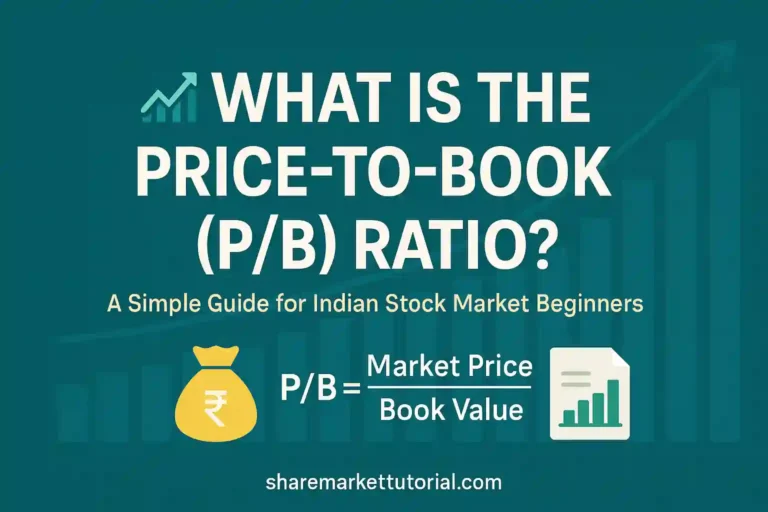When investing in the stock market, understanding financial ratios is important. One of the useful ratios is the Price-to-Book (P/B) Ratio. In this blog post, we will explain what the P/B ratio means, how to calculate it, why it matters, and how Indian investors can use it while choosing stocks.
What is Price-to-Book (P/B) Ratio?
The P/B ratio is a financial tool that compares a company’s current market price to its Book Value. In simple words, it shows how much investors are paying for each rupee of a company’s net assets.
Full form: Price-to-Book Ratio
Also known as: Price/Book ratio or Market-to-Book ratio
If a company has a low P/B ratio, it may mean that the stock is undervalued. A high P/B ratio may indicate that the stock is overvalued.
How to Calculate P/B Ratio?
The formula for the P/B ratio is:
P/B Ratio = Market Price per Share / Book Value per Share
Example:
Let’s say a company’s stock price is Rs. 200 and its book value per share is Rs. 100.
P/B Ratio = 200 / 100 = 2.0
This means investors are paying Rs. 2 for every Re. 1 of the company’s net assets.
Why is P/B Ratio Important?
The P/B ratio helps investors understand whether a stock is fairly priced.
- P/B < 1: The stock might be undervalued.
- P/B = 1: Fairly valued.
- P/B > 1: The stock may be overvalued.
But remember, these are general rules. The actual meaning can vary by industry.
P/B Ratio in the Indian Stock Market
In India, many investors use the P/B ratio, especially while analysing companies in sectors like:
- Banking
- Finance
- Insurance
These industries usually have large tangible assets, so the P/B ratio works well.
Example: Suppose SBI has a share price of Rs. 600 and a book value per share of Rs. 350. Then:
P/B Ratio = 600 / 350 = 1.71
This tells us how much more the market is willing to pay above the actual value of the bank’s assets.
Limitations of P/B Ratio
- Not suitable for companies with high intangible assets (like IT or pharma firms).
- Does not consider future growth or earnings potential.
- Can be misleading if the book value is outdated or wrongly calculated.
P/B vs. Other Ratios
The P/B ratio is often compared with the P/E (Price-to-Earnings) Ratio:
- P/E Ratio: Shows what investors are paying for each rupee of earnings.
- P/B Ratio: Shows what investors are paying for each rupee of book value.
Use both ratios together to make better investment decisions.
Conclusion
The Price-to-Book (P/B) ratio is a simple yet powerful tool to analyse stocks, especially in asset-heavy sectors like banking and finance. However, it should not be the only ratio you rely on. Always combine it with other tools and do complete research before investing.
PB Ration FAQs
Q1: What is a good P/B ratio for Indian stocks?
A: A P/B ratio below 1 may indicate undervaluation. But it depends on the industry and company fundamentals.
Q2: Can P/B ratio be negative?
A: Yes, if a company has more liabilities than assets (negative book value), the P/B ratio can be negative.
Q3: Is P/B ratio useful for all sectors?
A: No, it is best for sectors with high tangible assets like banking or manufacturing.
Q4: What is the difference between P/E and P/B ratio?
A: P/E looks at earnings, while P/B looks at asset value. Use both for better analysis.
Q5: Where can I check the P/B ratio of Indian stocks?
A: You can find it on websites like NSE India.

